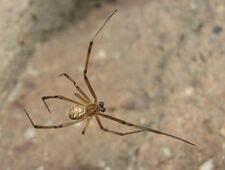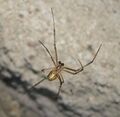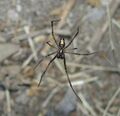Biology:Latrodectus hesperus
| Latrodectus hesperus | |
|---|---|

| |
| Latrodectus hesperus female | |
| Scientific classification | |
| Domain: | Eukaryota |
| Kingdom: | Animalia |
| Phylum: | Arthropoda |
| Subphylum: | Chelicerata |
| Class: | Arachnida |
| Order: | Araneae |
| Infraorder: | Araneomorphae |
| Family: | Theridiidae |
| Genus: | Latrodectus |
| Species: | L. hesperus
|
| Binomial name | |
| Latrodectus hesperus Chamberlin & Ivie, 1935[1]
| |
Latrodectus hesperus, the western black widow spider or western widow, is a venomous spider species found in western regions of North America. The female's body is 14–16 mm (1/2 in) in length and is black, often with an hourglass-shaped red mark on the lower abdomen. This "hourglass" mark can be yellow, and on rare occasions, white. The male of the species is around half this length and generally a tan color with lighter striping on the abdomen. The population was previously described as a subspecies of Latrodectus mactans and it is closely related to the northern species Latrodectus variolus. The species, as with others of the genus, build irregular or "messy" webs: unlike the spiral webs or the tunnel-shaped webs of other spiders, the strands of a Latrodectus web have no apparent organization.
Female black widows have potent venom containing a neurotoxin active against a range of mammals (see latrodectism). In humans, symptoms of this venom include pain, nausea, goosebumps, and localized sweating. In historical literature, fatalities were reported at anywhere between 0.5% and 12%,[2] but studies within the past several decades have been unable to confirm any fatalities from this or any of the other U.S. species of Latrodectus (e.g. zero fatalities among 23,409 documented Latrodectus bites from 2000 through 2008).[3] The female's consumption of the male after courtship, a cannibalistic and suicidal behavior observed in Latrodectus hasseltii (Australia's redback),[4] is rare in this species. Male western widows may breed several times during their relatively short lifespans.[5] Males are known to show preference for mating with well-fed females over starved ones, taking cues from the females' webs.[6]
Range
Latrodectus hesperus can be found in western regions of North America. In Canada it can be found from British Columbia to Manitoba. They are most commonly found near the Canada-US border, as well as less commonly throughout the grasslands of the Canadian Prairies in Western Canada.[7][8]
Mating
Courtship behavior
The female is stimulated upon contact of a male's web, and vice versa. Male and female L. hesperus produce sexually-specific scents that are combined with their silk; each sex responds by initiating mating when it comes in contact with a web of the opposite sex.[9] On initiating courting, the male L. hesperus will utilize his tarsi to tap the lines of the female's web. The male will continue this tapping gesture with his pedipalps as he actively begins to explore the web. This exploration is intermixed with resting bouts. The male's body spasms, producing a high frequency vibration throughout his abdomen. In many instances, the female will not accept the males sexual display and will scare the male away. In some instances, the females will violently jerk their abdomen, similar to courting male displays, which ultimately leads to a positive reaction from the males and a more successful insemination.[10]
One strategy performed by the male L. hesperus to ensure a successful courtship with the female is to minimize the escape route options for the female within her own web. This is accomplished by the male severing the female's web at various locations that the male believes could provide the female with a course of action to avoid the male. Once the male has successfully made contact with the female's body, he swoons her by gently stroking various parts of her body. The male then creates what is known as the "bridal veil", which is simply silk thrown onto the female.[10]
The time spent on courting varies tremendously and can be as short as ten minutes or as long as two hours. Male's genital bulbs may get injured or partially destroyed in the act of copulation, which leaves him unable to mate again in the future. This may be the reason that many male mates are found dead in the female's web after copulation. Females will often consume these dead males for nutrients to improve her own reproductive success.[10]
Female choosiness
Female choosiness can be both evolutionarily advantageous and disadvantageous depending on whether the risk of delaying copulation will inevitably pay off with a better mate, or if it will instead cost the female her whole potential of producing offspring. In fact four percent of female L. hesperus did not acquire mates. The female L. hesperus has the potential to possess more than one mate during their lifespan.[11] This is in part due to the male-bias within the sexually active population of the spider. This sex-bias allows the males to engage in what is known as "scramble competition." Scramble competition means that no male possesses a monopoly over the resource, which in this case is the female spider, yet because there is a finite amount of this resource, those who exploit it faster will come out on top.[12] There are multiple ways in which the female L. hesperus can guarantee her right to choose, one of which is eating the male before copulation. The female receives chemical cues given off by other nearby L. hesperus that indicate the population density, and therefore give them a notion as to whether their choosiness will pay off or fail to do so.[11]
Hunting and diet
Hunting
Latrodectus hesperus frequently hangs upside down near center of the web and waits for any insects to enter the web to attack. It bites its victim then wraps it in silk.[13] There are multiple aspects of this spider's web that serve the purpose of capturing prey. The web incorporates hanging gum-footed threads that have liquid glue on them. When prey come into contact with these threads, they get stuck to them, causing the thread to break and the prey to be propelled up by the web to an easy point of access for the spider. The web of L. hesperus also allows for locomotive action by the spider when attacking prey through a sheet of silk.[14] In the months of May through October, there is a significant increase in the amount of prey caught by L. hesperus, presumably because these are the months in which the female produces her egg sacs, and in which the offspring are born and their survival is dependent on their mother's ability to feed them.[15]
Prey cues
Latrodectus hesperus follows prey cues when determining where to settle down. The female L. hesperus is able to detect chemical cues from their prey. As a by-product of this detection, L. hesperus is more likely to build a home in an area that is expressing a high degree of chemical prey cues. This finding may grant us the ability of controlling L. hesperus infestations. By killing off the prey of L. hesperus, there will be a correlated side-effect that pushes L. hesperus to relocate to a location where there are more available prey.[16]
Diet
Like other web-building spiders, L. hesperus are polyphagous and feed on prey from eight different arthropod orders. In one study in British Columbia, the orders Coleoptera and Hymenoptera accounted for the majority of the spiders' prey; the majority of prey within Coleoptera were darkling beetles, weevils, and ground beetles, and the most common Hymenoptera were ants, wasps, and bumblebees.[15] The peak activity of hymenopterans in this study was May through September in British Columbia, paralleling a spike in consumption by L. hesperus during these months.[15]
Latrodectus hesperus is an "opportunistic cannibal." There are three circumstances under which L. hesperus may feed on conspecifics: when alternative prey options are scarce; when a spider is starving; in self-defense during antagonistic bouts.[15]
Sibling cannibalism
As previously discussed, L. hesperus is an opportunistic cannibal.[15] There of course is variation amongst L. hesperus in terms of how dire a situation must become, or how hungry the spider must be, to resort to cannibalism. Specifically, within siblingships the range of time lapsed before the spider siblings fell victim to cannibalism varied from two days to three weeks. There appears to be a direct relationship between the length of time a L. hesperus will last before falling back on sibling cannibalism and the amount of maternal investment put into their egg sac. In other words, the more investment a mother puts into her egg sac, the longer their offspring will go before engaging in sibling cannibalism as their source of prey and nutrition.[17]
Webs and silks
Silks
The silk produced by L. hesperus is strongly adhesive.[18] The silk has a fiber at the center covered by some droplets of liquid adhesive protein.[18] When rubbing against one's fingers, it feels like the texture of rubber.[18] The droplets are about twenty times larger than the center fiber's diameter and are visible to the naked eye.[18]
The ultimate strength and other physical properties of L. hesperus silk were found to be similar to the properties of silk from orb-weaving spiders. The ultimate strength for the three kinds of silk measured in the study was about 1000 MPa (145,000 psi). The ultimate strength reported in a previous study for Trichonephila edulis was 1290±160 MPa[19] (188,000 psi). The ultimate strength of mild steel is about 800 MPa (116,000 psi).
Latrodectus hesperus produces three different types of silk: dragline silk, inner egg case silk, and scaffolding silk. Analysis of the amino acid composition of the various silks produced by L. hesperus show that both dragline silk and scaffolding silk are primarily composed of alanine and glycine, in fact neither cysteine nor methionine were detected at all in these silks. In the inner egg case silk, although alanine remained an abundant amino acid, its abundance was less so in this silk than the others.[20]
Latrodectus hesperus' silk contains sexual pheromones which are perceived by the opposite sex upon contact with the web. The males are able to locate the female and begin courting behavior in response to female pheromones. The female curtails her predatory reflexes against the male in response to male pheromones.[10]
Web architecture
L. hesperus produces cobwebs. Cobwebs differ from orb webs, and their architecture can be broken down into three sections. Two sections are utilized to capture prey, the gumfoot threads and the mesh region. The third section provides the structural support for the web and is known as the scaffold threads.[20] The gumfoot lines hang beneath the web, the liquid glue on these lines serves as a sticky substance to trap prey in. The line will break once prey catches on it, creating a tensile force within the web that pulls the line along with the prey up to the spider. L. hesperus seeks refuge in the location from which the web originates and emerges.[14]
Web behavior
Latrodectus hesperus reacts to changes in prey capture by altering its web-spinning behavior. When the spider reaches satiety, it will decrease its energy expenditure on building the features of the web specifically purposed for prey capture. This is evolutionarily advantageous for the spider because it is already satiated. Therefore, it would be a waste of energy to seek out more nutrients. Although there is a decrease in prey-capturing aspects of the web, the overall silk production remains steady or in some cases will increase. L. hesperus also decrease silk investment into webs when preparing for offspring by alternatively increasing silk investment into egg sac production.[14]
Defensive behavior
The black widow spiders face some predators, like mice, which are omnivorous and larger than the black widow.[18] Juveniles and female adult L. hesperus can eject a chunk of viscid silk toward potential predators.[18] This silk is not toxic, but its mechanical irritation can thwart most predators.[18] However, adult males are unable to produce this defensive silk, presumably because they need to conserve energy for reproduction during their relatively short life span.[18] However, this defensive behavior is very important to females, which are under heavy predation pressure.[18] Black widow spiders spend much time on web construction at night, which is also an active time for ground mice.[18] If the webs are low above ground, it is easy for mice and other predators to attack from below.[18] Since the spider will stay largely stationary at the web hub, such attacks are mostly successful if there is no defensive behavior.[18]
Venom
Latrodectus hesperus' bite is similar to that of other Latrodectus species because of their relatedness. The venom is exuded from the spiders' fangs and injected into the enemy. The spiders' prey is paralyzed by the venom, which enables their future digestion. For humans, the venom behaves like a neurotoxin, affecting the neurotransmitter acetylcholine. The female is more of a threat than the male in this species, however her aggressive side only comes out when she is protecting her eggs.[21] Not only are the females fangs larger than the males, but their venomous glands are also more distinct. The effects of their bite can range from a simple irritation to severe autonomic disparities. The venom is composed of proteins, peptides, and proteases. The venom causes an excess release of neurotransmitters which can cause a slew of symptoms. Some of these symptoms include muscle rigidity, perspiration, and nausea. Treatments include painkillers and antivenom if the toxicity is severe enough.[22]
Gallery
References
- ↑ "Taxon details Latrodectus hesperus Chamberlin & Ivie, 1935". World Spider Catalog. Natural History Museum Bern. http://www.wsc.nmbe.ch/species/39049. Retrieved 2017-04-05.
- ↑ Bettini, S. (1964). Epidemiology of latrodectism. Toxicon, 2(2), 93–102
- ↑ Monte AA, Bucher-Bartelson B, Heard KJ (2011) A US perspective of symptomatic Latrodectus spp. envenomation and treatment: a National Poison Data System review. Annals of Pharmacotherapy 45(12):1491-8. doi: 10.1345/aph.1Q424
- ↑ Andrade, Maydianne C. B. (5 January 1996). "Sexual Selection for Male Sacrifice in the Australian Redback Spider". Science 271 (5245): 70–2. doi:10.1126/science.271.5245.70. Bibcode: 1996Sci...271...70A. http://www.sciencemag.org/cgi/content/abstract/271/5245/70. Retrieved 2007-01-15.
- ↑ "Black Widow Spiders". Hastings Reserve. http://www.hastingsreserve.org/Invertebrates/Arachnids/BlackWidows/BlackWidowSpiders.html.
- ↑ Johnson, J. Chadwick; Trubl, Patricia Trubl; Blackmore, Valerie; Miles, Lindsay (2011). "Male black widows court well-fed females more than starved females: silken cues indicate sexual cannibalism risk". Animal Behaviour 82 (2): 383–390. doi:10.1016/j.anbehav.2011.05.018.
- ↑ "Western Black Widow (Latrodectus hesperus)". http://www.royalalbertamuseum.ca/research/lifeSciences/invertebrateZoology/bugsfaq/blackwid.htm. Retrieved 23 May 2016.
- ↑ "NCC Black Widow". Government of Canada. https://www.natureconservancy.ca/en/what-we-do/resource-centre/featured-species/insects-and-spiders/black-widow.html.
- ↑ Ross, Kenneth (1979). "Aspects of the Courtship Behavior of the Black Widow Spider, Latrodectus hesperus (Araneae: Theridiidae), with Evidence for the Existence of a Contact Sex Pheromone". The Journal of Arachnology 7 (1): 69–77. http://www.americanarachnology.org/JoA_free/JoA_v7_n1/%20JoA_v7_p69.pdf. Retrieved 2019-11-14.
- ↑ 10.0 10.1 10.2 10.3 Ross, Kenneth; Smith, Robert L. (1979). "Aspects of the Courtship Behavior of the Black Widow Spider, Latrodectus hesperus (Araneae: Theridiidae), with Evidence for the Existence of a Contact Sex Pheromone". The Journal of Arachnology 7 (1): 69–77. ISSN 0161-8202. https://www.jstor.org/stable/3704955.
- ↑ 11.0 11.1 Scott, Catherine E.; McCann, Sean; Andrade, Maydianne C. B. (2020-06-02). "Black widows as plastic wallflowers: female choosiness increases with indicators of high mate availability in a natural population" (in en). Scientific Reports 10 (1): 8981. doi:10.1038/s41598-020-65985-z. ISSN 2045-2322. PMID 32488193.
- ↑ Łomnicki, A. (2008-01-01), Jørgensen, Sven Erik; Fath, Brian D., eds. (in en), Competition and Behavior, Oxford: Academic Press, pp. 695–700, doi:10.1016/b978-008045405-4.00005-7, ISBN 978-0-08-045405-4, http://www.sciencedirect.com/science/article/pii/B9780080454054000057, retrieved 2020-11-16
- ↑ "How to Get Rid of Black Widow Spiders" (in en). https://atkinsinc.com/pest-control/spiders/black-widow-spiders/.
- ↑ 14.0 14.1 14.2 Blackledge, Todd A.; Zevenbergen, Jacquelyn M. (2007-05-01). "Condition-dependent spider web architecture in the western black widow, Latrodectus hesperus" (in en). Animal Behaviour 73 (5): 855–864. doi:10.1016/j.anbehav.2006.10.014. ISSN 0003-3472. http://www.sciencedirect.com/science/article/pii/S0003347207000528.
- ↑ 15.0 15.1 15.2 15.3 15.4 Salomon, Maxence (2011). "The natural diet of a polyphagous predator, Latrodectus hesperus (Araneae: Theridiidae), over one year". The Journal of Arachnology 39 (1): 154–160. doi:10.1636/P10-25.1. ISSN 0161-8202. https://www.jstor.org/stable/23048793.
- ↑ Johnson, Amanda; Revis, Orenda; Johnson, J. Chadwick (2011). "Chemical prey cues influence the urban microhabitat preferences of Western black widow spiders, Latrodectus hesperus". The Journal of Arachnology 39 (3): 449–453. doi:10.1636/Hi11-19.1. ISSN 0161-8202. https://www.jstor.org/stable/23070792.
- ↑ Johnson, J. Chadwick; Kitchen, Kathryn; Andrade, Maydianne C. B. (May 2010). "Family Affects Sibling Cannibalism in the Black Widow Spider, Latrodectus hesperus: Sibling Cannibalism in Black Widow Spiders" (in en). Ethology: no. doi:10.1111/j.1439-0310.2010.01792.x. http://doi.wiley.com/10.1111/j.1439-0310.2010.01792.x.
- ↑ 18.00 18.01 18.02 18.03 18.04 18.05 18.06 18.07 18.08 18.09 18.10 18.11 Vetter, Richard S. (September 1980). "Defensive behavior of the black widow spider Latrodectus hesperus (Araneae: Theridiidae)". Behavioral Ecology and Sociobiology 7 (3): 187–193. doi:10.1007/bf00299363. ISSN 0340-5443. http://dx.doi.org/10.1007/bf00299363.
- ↑ Blackledge, Todd. "Quasistatic and continuous dynamic characterization of the mechanical properties of silk from the cobweb of the black widow spider Latrodectus hesperus, table 1". The Company of Biologists. http://jeb.biologists.org/cgi/content-nw/full/208/10/1937/TBL1. Retrieved 2009-01-23.
- ↑ 20.0 20.1 Casem, Merri Lynn; Turner, Dianna; Houchin, Kelly (1999-03-01). "Protein and amino acid composition of silks from the cob weaver, Latrodectus hesperus (black widow)" (in en). International Journal of Biological Macromolecules 24 (2): 103–108. doi:10.1016/S0141-8130(98)00078-6. ISSN 0141-8130. PMID 10342753. http://www.sciencedirect.com/science/article/pii/S0141813098000786.
- ↑ Salyer, Steven W. (2007-01-01), Salyer, Steven W., ed., "Chapter 6 - Environmental Emergencies" (in en), Essential Emergency Medicine (Philadelphia: W.B. Saunders): pp. 183–260, doi:10.1016/b978-141602971-7.10006-6, ISBN 978-1-4160-2971-7, http://www.sciencedirect.com/science/article/pii/B9781416029717100066, retrieved 2020-12-16
- ↑ Williams, Mollie; Anderson, Jackie; Nappe, Thomas M. (2020), "Black Widow Spider Toxicity", StatPearls (Treasure Island (FL): StatPearls Publishing), PMID 29763163, http://www.ncbi.nlm.nih.gov/books/NBK499987/, retrieved 2020-12-16
- Minus, A. 2001. "Latrodectus hesperus" (On-line), Animal Diversity Web. Accessed March 8, 2009
External links
Wikidata ☰ Q113414 entry
 |















